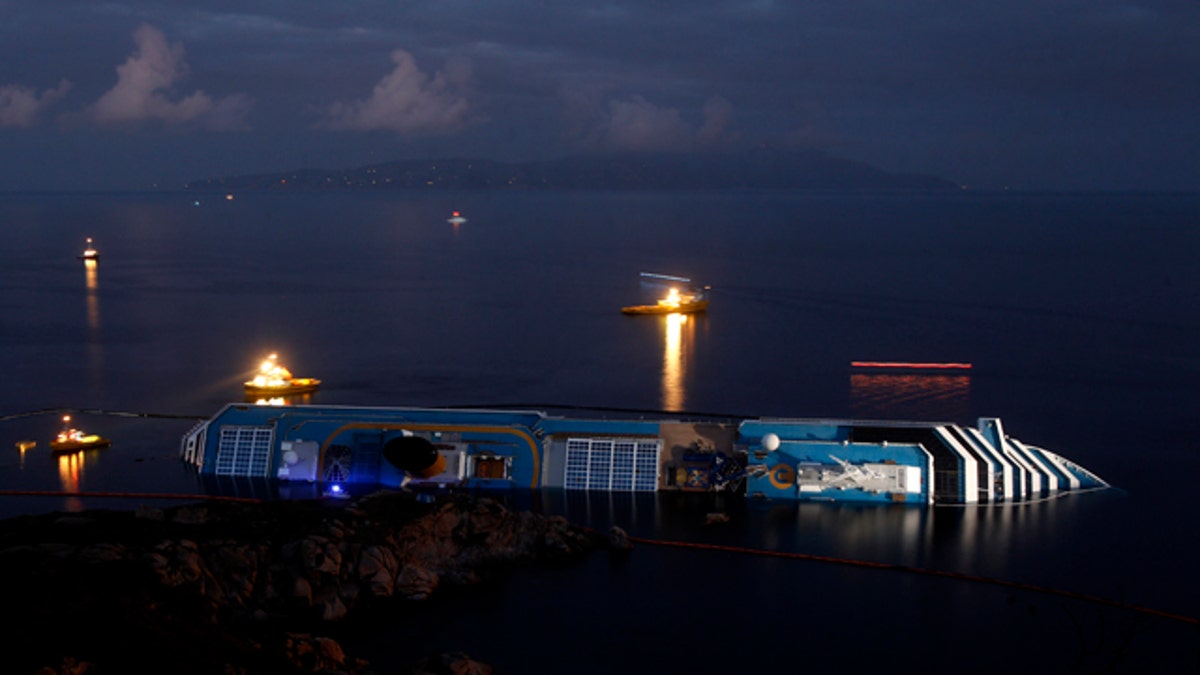
Jan. 23: The grounded cruise ship Costa Concordia lies on its side off the Tuscan island of Giglio, Italy. (AP)
GIGLIO, Italy – Italian officials discovered a sixteenth body while searching the wrecked Costa Concordia while operations are under way to remove a half-million gallons of fuel from the ship before it creates an environmental disaster off the coast of Giglio, Italy.
The most recent body was discovered on the third floor deck. Italian news reports say it was a woman’s body.
Beside the recovery effort, Italian authorities are faced with the urgent task of pumping oil from the ship, which is expected to begin sometime this weekend.
Officials have identified an initial six tanks that will be tapped, located in a relatively easy-to-reach area of the ship. Franco Gabrielli, head of the national civil protection agency, says once they are emptied, 50 percent of the fuel aboard the ship will have been extracted.
The decision to carry out both operations was made after instrument readings determined that the Costa Concordia did not risk sliding into a deeper seabed, said Franco Gabrielli, chief of the national civil protection agency.
"The ship is stable. ... There is no problem or danger that it is about to drop onto much lower seabed," Gabrielli told reporters Monday on Giglio.
The Concordia rammed a reef Jan. 13 on the tiny Tuscan island and capsized a few hours later just outside Giglio's port with 4,200 passengers and crew aboard for a Mediterranean cruise.
There are 16 people still unaccounted for, but Gabrielli has said unregistered Hungarian woman might have been aboard ship. The woman's relatives have told Italian authorities they haven't heard from her since when she called them to say she was aboard the ship.
In all, seven bodies await identification, but Gabrielli said officials have DNA from the relatives of all of the missing passengers and are working to confirm names and nationalities.
Meanwhile, Italian Admiral Ilarione dell'Anna said the fuel removal could begin as early as Tuesday, addressing growing concern among residents and environmentalists that the heavy, tar-like fuel could leak from the ship's 17 double-bottomed tanks.
"They should start the oil drainage operations on the ship. At this point those who died will not come back to life. Even if they pull them out later, unfortunately it won't make a difference," Andrea Ginanneschi, a resident of Giglio, told The Associated Press.
Officials said the first tank to be emptied will be one above the waterline.
Five miles of oil barriers, including absorbent ones, have been laid to protect marine life and the coastline in the pristine waters off Giglio, which are prime fishing grounds and a protected area for dolphins and whales.
Recovery experts from the Dutch salvage company Smit have previously said they will create holes in the top and the bottom of each tank, heating the fuel so it flows more easily and pumping from the top while forcing air in from the bottom. For the underwater tanks, sea water will be used to displace the fuel, which becomes thick and gooey when cooled.
Dell'Anna predicted it would take 28 days to remove all of the fuel, without any interruptions.
Already, some diesel and lubricants have leaked into the water near the ship, probably from machinery on board. Officials have characterized the contamination as superficial.
Smit has been ready for a week to begin pumping fuel from the tanks, awaiting only the go ahead.
The company said Monday that Italian authorities have indicated it can begin the removal once a second absorbent boom is in place around the ship and following the arrival of an oil removal vessel, expected later Monday. The booms are used "to reduce the possibility of polluting shorelines and to help make recovery easier," the company said in a statement.
Besides 2,200 metric tons of heavier fuel, there also are 185 metric tons of diesel and lubricants on board -- some dispersed in machinery and lifeboats, and not in 17 double-bottomed tanks that hold most of the fuel -- in addition to chemicals including cleaning products and chlorine.
The Associated Press contributed to this report.




















